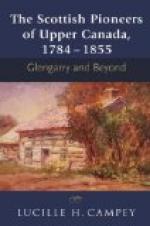[Footnote 6: Cape Breton was not then, or for nearly two hundred years afterwards, known to be an island. It was thought to be part of the “island” (peninsula) of what we now call Nova Scotia, and the whole of this region which advances so prominently into the Atlantic was believed to be at first the great unknown “New Island” of Irish and English legends—legends based on the Norse discoveries of the eleventh century. Cape Breton was thus named by the Breton seaman who came thither soon after the Cabot expeditions to fish for cod. This large island is separated from Nova Scotia by the Gut of Canso, a strait no broader than a river.]
[Footnote 7: Dr. S.E. DAWSON (The St. Lawrence Basin) says of this voyage: “When the forest wilderness of Cape Breton listened to the voices of Cabot’s little company (of Bristol mariners) it was the first faint whisper of the mighty flood of English speech which was destined to overflow the continent to the shores of another ocean....”]
They encountered no inhabitants, though they found numerous traces of their existence in the form of snares, notched trees, and bone netting needles. John Cabot hoisted the English flag of St. George and the Venetian standard of St. Mark; then—perhaps after coasting a little along Nova Scotia—fearful that a longer stay might cause them to run short of provisions, he turned the prow of the Matthew eastward, and reached Bristol once more about August 6, and London on August 10, 1497, with his report to King Henry VII, who rewarded him with a donation of L10. He was further granted a pension of L20 a year (which he only drew for two years, probably because he died after returning from a second voyage to the North-American coast), and he received a renewal of his patent of discovery in February, 1498. In this patent it is evidently inferred that King Henry VII assumed a sovereignty over these distant regions because of John Cabot’s hoisting of the English flag on “the new Isle” (Cape Breton Island) in the preceding year.
The new expedition of 1498 was a relatively important affair. The king assisted to finance the ventures of the Bristol captains, and five of his ships formed part of the little fleet. It is probable that John Cabot was in command, and almost certain that his young son Sebastian was a passenger, possibly an assistant pilot. The course followed lay much farther to the north, and brought the little sailing vessels amongst the icebergs, ice floes, polar bears, and stormy seas of Greenland and Labrador. Commercially the voyage was a failure, almost a disaster. The ships returned singly, and after a considerable interval of time. Nevertheless, some of the king’s loans were repaid to him; and in 1501 a regular chartered company was formed (perhaps at Bristol), with three Bristolians and three Portuguese as directors. Henry VII not only gave a royal patent to this association, but lent more money to enable it to explore and colonize these new lands across the western sea.




